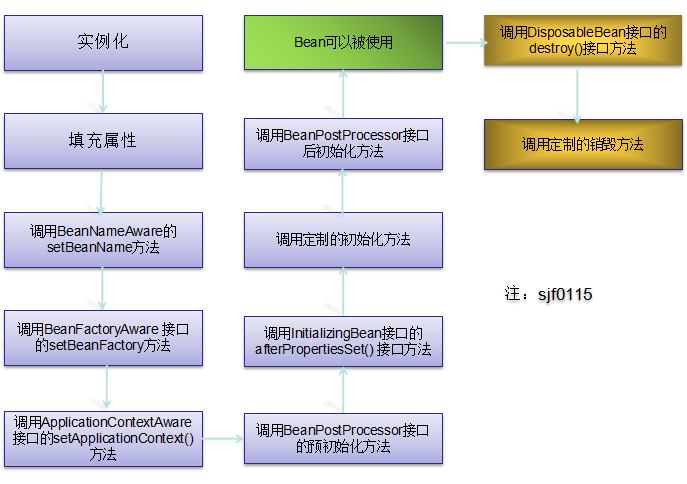1. 生命周期流程图

Bean在Spring容器中从创建到销毁经历了若干个阶段,在每一个阶段都可以针对Spring如何管理Bean进行个性化定制。
正如你所见,在Bean 准备就绪之前,Bean 工厂执行了若干启动步骤。
- Spring 对Bean 进行实例化。
- Spring 将值和Bean 的引用注入进Bean 对应的属性中。
- 如果Bean 实现了BeanNameAware接口,Spring 将Bean的ID传递给setBeanName() 接口方法。
- 如果Bean 实现了BeanFactoryAware接口,Spring 将调用setBeanFactory()接口方法,将BeanFactory 容器实例传入。
- 如果Bean 实现了ApplicationContextAware 接口,Spring 将调用setApplicationContext()接口方法,将应用上下文的引用传入。
- 如果Bean 实现了BeanPostProcessor 接口,Spring 将调用它们的postProcessBeforeInitialization() 接口方法。
- 如果Bean 实现了InitializingBean 接口,Spring 将调用它们的afterPropertiesSet() 接口方法。类似地,如果Bean 使用init-method 声明了初始化方法,该方法也会被调用。
- 如果Bean 实现了BeanPostProcessor 接口,Spring 将调用它们的postPoressAfterInitialization() 接口方法。
- 此时此刻,Bean 已经准备就绪,可以被应用程序使用了,它们将一直驻留在应用上下文中,直到该应用上下文被销毁。
- 如果Bean 实现了DisposableBean 接口,Spring 将调用它的destroy()接口方法。同样,如果Bean 使用destroy-method 声明了销毁方法,该方法也会被调用。
2. 各种接口方法分类
Bean的完整生命周期经历了各种方法调用,这些方法可以划分为以下几类:
| 方法 | 用途 |
| Bean自身的方法 | 这个包括了Bean本身调用的方法和通过配置文件中<bean>的init-method和destroy-method指定的方法 |
| Bean级生命周期接口方法 | 这个包括了BeanNameAware、BeanFactoryAware、InitializingBean和DiposableBean这些接口的方法 |
| 容器级生命周期接口方法 | 这个包括了InstantiationAwareBeanPostProcessor 和 BeanPostProcessor 这两个接口实现,一般称它们的实现类为“后处理器”。 |
| 工厂后处理器接口方法 | 这个包括了AspectJWeavingEnabler, ConfigurationClassPostProcessor, CustomAutowireConfigurer等等非常有用的工厂后处理器接口的方法。工厂后处理器也是容器级的。在应用上下文装配配置文件之后立即调用。 |
3. 实例
我们用一个简单的Spring Bean来演示一下Spring Bean的生命周期。
首先是一个简单的Spring Bean,它实现了BeanNameAware,BeanFactoryAware,InitializingBean,ApplicationContextAware和DiposableBean这5个接口,同时有2个方法(myInit()方法和myDestroy方法),对应配置文件中<bean>的init-method和destroy-method。
package com.sjf.bean;import org.springframework.beans.BeansException;import org.springframework.beans.factory.BeanFactory;import org.springframework.beans.factory.BeanFactoryAware;import org.springframework.beans.factory.BeanNameAware;import org.springframework.beans.factory.DisposableBean;import org.springframework.beans.factory.InitializingBean;import org.springframework.context.ApplicationContext;import org.springframework.context.ApplicationContextAware;/*** Student实体类* @author sjf0115**/public class Student implements BeanNameAware,BeanFactoryAware,InitializingBean,ApplicationContextAware, DisposableBean{private String name;private int age;private String school;// 构造器public Student(){System.out.println("constructor Student...");}public void setName(String name) {this.name = name;System.out.println("setName...");}public void setAge(int age) {this.age = age;System.out.println("setAge...");}public void setSchool(String school) {this.school = school;System.out.println("setSchool...");}public void myInit(){System.out.println("init-method...");}public void myDestroy(){System.out.println("destroy-method...");}// 来自于BeanNameAware接口public void setBeanName(String arg0) {System.out.println("setBeanName...[" + arg0 + "]");}// 来自于BeanFactoryAware接口public void setBeanFactory(BeanFactory arg0) throws BeansException {System.out.println("setBeanFactory...");}// 来自于InitializingBeanpublic void afterPropertiesSet() throws Exception {System.out.println("afterPropertiesSet...");}// 来自于DisposableBeanpublic void destroy() throws Exception {System.out.println("destroy...");}// 来自于ApplicationContextAware接口public void setApplicationContext(ApplicationContext arg0) throws BeansException {System.out.println("setApplicationContext...");}@Overridepublic String toString() {return "name:" + name + " age:" + age + " school:" + school;}}
然后是自定义一个MyBeanPostProcessor Bean,实现了
BeanPostProcessor接口。
package com.sjf.bean;import org.springframework.beans.BeansException;import org.springframework.beans.factory.config.BeanPostProcessor;/*** 自定义BeanPostProcessor* @author sjf0115**/public class MyBeanPostProcessor implements BeanPostProcessor{public MyBeanPostProcessor(){System.out.println("constructor MyBeanPostProcessor...");}// 来自于BeanPostProcessor接口public Object postProcessAfterInitialization(Object arg0, String arg1) throws BeansException {System.out.println("postProcessAfterInitialization...[" + arg1 + "]");return arg0;}// 来自于BeanPostProcessor接口public Object postProcessBeforeInitialization(Object arg0, String arg1) throws BeansException {System.out.println("postProcessBeforeInitialization...[" + arg1 + "]");return arg0;}}
BeanPostProcessor接口包括2个方法postProcessAfterInitialization()和postProcessBeforeInitialization(),这两个方法的第一个参数都是要处理的Bean对象,第二个参数都是Bean的name。返回值也都是要处理的Bean对象。
接口中的两个方法都要将传入的bean返回,而不能返回null,如果返回的是null那么我们通过getBean方法将得不到目标。
一般ApplicationContext会自动检查是否在定义文件中有实现了BeanPostProcessor接口的类,如果有的话,Spring容器会在每个Bean(其他的Bean)被初始化之前和初始化之后,分别调用实现了BeanPostProcessor接口的类的postProcessAfterInitialization()方法和postProcessBeforeInitialization()方法,对Bean进行相关操作。刚开始
只定义了
Student
一个bean,并且实现了BeanPostProcessor接口,并不会调用
postProcessAfterInitialization()和postProcessBeforeInitialization()方法,这时ApplicationContext找不到
实现了BeanPostProcessor接口的类。
所以这里一个
Bean用来实现BeanPostProcessor接口,然后另一个Bean用来配合实现了BeanPostProcessor接口的Bean。
网友的疑问以及解答:
http://bbs.csdn.net/topics/300121037
配置文件applicationContext.xml:
<?xml version="1.0" encoding="UTF-8"?><beans xmlns="http://www.springframework.org/schema/beans"xmlns:xsi="http://www.w3.org/2001/XMLSchema-instance"xsi:schemaLocation="http://www.springframework.org/schema/beans http://www.springframework.org/schema/beans/spring-beans.xsd"><bean id = "yoona" class = "com.sjf.bean.Student" scope="singleton" init-method="myInit" destroy-method="myDestroy"><property name="name" value="yoona"/><property name="age" value="24"/><property name="school" value="西电"/></bean><bean id = "myBeanPostProcessor" class="com.sjf.bean.MyBeanPostProcessor"/></beans>
测试代码:
package com.sjf.bean;import org.springframework.context.ApplicationContext;import org.springframework.context.support.ClassPathXmlApplicationContext;/*** 测试类* @author sjf0115**/public class Test {private static ApplicationContext context;private static Student stu;public static void main(String[] args) {context = new ClassPathXmlApplicationContext("applicationContext.xml");// 2. 从IOC容器中获取Bean实例stu = (Student)context.getBean("yoona");// 3.调用listAllBook方法System.out.println(stu.toString());// 4.关闭容器((ClassPathXmlApplicationContext) context).registerShutdownHook();}}
运行结果:
constructor MyBeanPostProcessor...constructor Student...setName...setAge...setSchool...setBeanName...[yoona]setBeanFactory...setApplicationContext...postProcessBeforeInitialization...[yoona]afterPropertiesSet...init-method...postProcessAfterInitialization...[yoona]name:yoona age:24 school:西电destroy...destroy-method...
从这个运行结果中我们就可以看出一个Bean的生命周期:constructor(
实例化) -> setXXX(
填充属性) -> BeanName(
BeanNameAware接口) -> BeanFactory(
BeanFactoryAware接口) -> ApplicationContext(
ApplicationContextAware接口
) -> postProcessBeforeInitialization(BeanPostProcessor接口) -> afterPropertiesSet(
InitializingBean接口
) -> init-method(定制的初始化方法) -> postProcessAfterInitialization
(BeanPostProcessor接口)
-> destroy(
DisposableBean接口
) -> destroy-method(定制的销毁方法)
来源于:《Spring实战》
























 107
107











 被折叠的 条评论
为什么被折叠?
被折叠的 条评论
为什么被折叠?










